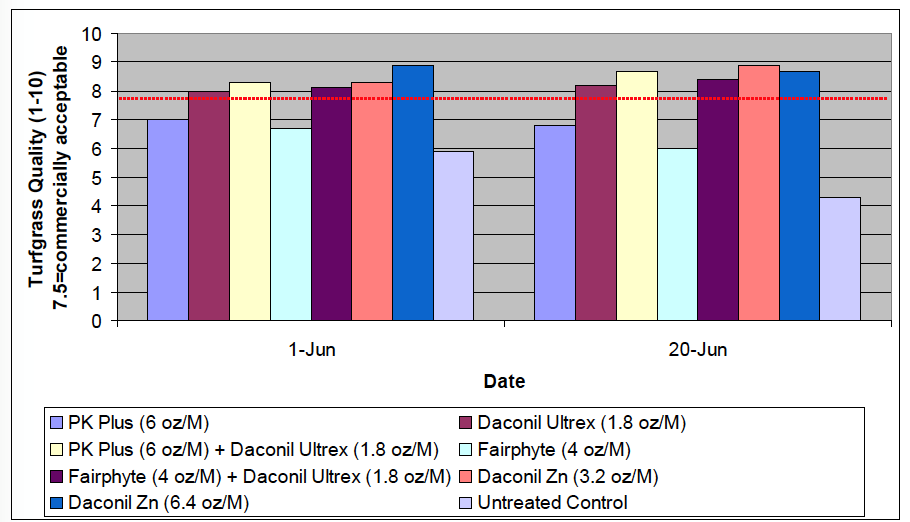Algae Suppression in Tee Height Creeping Bentgrass
Research Topic: Algae Suppression in Tee Height Creeping Bentgrass (2007), S. McDonald, Turfgrass Disease Solutions, LLC
Algae growth and subsequent competition on turfgrass sites (greens and tees) can be difficult to diagnose leading to reduced turfgrass quality. Commercially available algaecides (Daconil Ultrex™ and Daconil Zn™) exist, but should be used as one component in an integrated approach to algae suppression, in part because yearly
chlorothalonil restrictions limit repeated and extended use. Cultural practices such as improved drainage, thatch reduction, and increased mowing heights and sunlight penetration can also be implemented. This trial was conducted to determine whether phosphite containing fertilizers applied alone or in combination with low label rates of Daconil Ultrex, can provide a specific best management approach (BMP’s) to algae suppression for golf course superintendents. The trial was conducted on the ‘Research Tee’ of Philadelphia Country Club located in Gladwyne, Pennsylvania. Turf was maintained as a typical golf course tee and considered poorly draining and thatchy with a history of severe algal problems (blue-green algae, cynobacteria). The turf consisted of ‘Princeville’ creeping bentgrass and received 1.0 lb N per 1000 ft2 (48 kg N per ha) from 19-5-25 on 20 May 2007. Plots were rated as percent blue - green algae (PABA). On 25 May plots treated with each rate of Daconil ZN (6.5 and 8.0 PABA), Daconil Ultrex-alone, and the tank-mixes of Daconil Ultrex + P-K Plus® and Fairphyte provided the highest level of algae suppression. During the first and second week of June the algae pressure significantly increased and treatment differences became more apparent. Plots treated with both rates of Daconil ZN, and P-K Plus + Daconil Ultrex had significantly less PABA than P-K Plus-alone, Daconil Ultrex-alone, Fairphyte-alone, and Fairphyte® + Daconil Ultrex and the untreated control (Figure 1). On each rating date, P-K Plus provided a higher level of algae suppression when compared to the other phosphite fertilizer included in this trial, Fairphyte (Figure 1). Turfgrass quality was rated twice throughout the trial (June 1&20). The largest factor influencing turfgrass quality was the presence of dollar spot and algae. On June 1, the untreated control quality fell below the acceptable threshold (7.5), while plots treated with P-K Plus or Fairphyte combined with the low label rate of Daconil Ultrex remained
above the level of commercially acceptable quality (Figure 2.). On 20 June, plots treated with Daconil ZN at the 3.2 fl oz rate had significantly better quality than Fairphyte + Daconil Ultrex, and PK Plus and Fairphyte-applied-alone, but was similar quality to the P-K Plus + Daconil Ultrex (1.8 oz) (Figure 2). PK plus treated plots had better turfgrass
quality than Fairphyte, which was significantly better than the untreated control. The results from this study show that a phosphite containing fertilizer, specifically P-K Plus, combined with a low label rate (1.8 oz) of Daconil Ultrex will suppress algae and provide a high level of turfgrass quality. Future research will be performed on
additional test sites and with different mowing heights to confirm these findings and develop specific best management practices (BMP’s) for algae suppression.

Figure 1. Effect of fertilizers algaecides and fertilizers containing phosphite on percent (%) algae suppression on a creeping bentgrass tee

Figure 2. Effect of algaecides and fertilizers containing phosphite applied alone or in combination on overall turfgrass quality